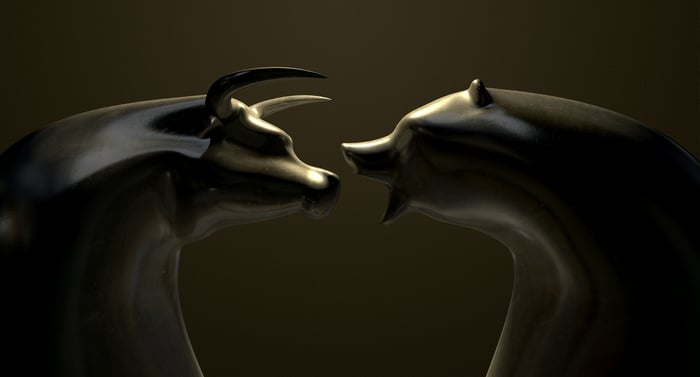Inflation is measured using the Consumer Price Index (CPI), an ongoing survey that tracks the change in price of a large basket of goods and services by comparing it to a previous point in time.
The U.S. Federal Reserve has been tasked with trying to keep the CPI growing by an average of 2% each year. One way it does this is by adjusting the federal funds rate (also called the prime lending rate), which affects overall interest rates. Large swings above or below that target can have a huge influence on the price of assets like stocks, bonds, and housing.
2023 is now in the books and the CPI declined significantly. A comparable drop hasn't been seen since 2009 and 1982, and those occasions marked two of the longest winning streaks for the S&P 500 (^GSPC 1.02%) in stock market history. Here's why it could happen again.
The CPI plunged 3.9 percentage points in 2023
As I mentioned at the top, the Fed wants to keep the CPI increasing by around 2% each year. In 2022, it rocketed to a 40-year high of 8% due to a mixture of inflationary conditions in the economy:
- The U.S. government injected trillions of dollars of stimulus into the economy to combat the effects of the pandemic in 2020 and 2021.
- The Fed held the federal funds rate at a historic low of 0.25% from March 2020 until March 2022, so the price of money was extremely cheap.
- The Fed also increased the money supply by trillions of dollars using quantitative easing (QE).
- Factories around the world temporarily shut down due to COVID-19 restrictions, leading to disruptions in supply chains, which sent the price of many goods soaring.
Considering most pandemic lockdowns and social restrictions ended in 2021 thanks to the rollout of vaccines, some economists think the government and the Fed maintained stimulative policies for far too long, which stoked inflation.
The Fed's next move supported that view. In just 18 months (beginning in March 2022), it raised the federal funds rate from 0.25% to 5.5% -- one of the fastest hiking cycles in the central bank's history. The mixture of high inflation and soaring interest rates sent the S&P 500 plunging by 18% in 2022.
Here's the good news: The tighter monetary policy is working because the CPI ended 2023 at 4.1%, marking a drop of 3.9 percentage points from that lofty 8% level in 2022.
The CPI dropped by a similar amount in 2009 and 1982
The last time the CPI experienced a comparatively steep drop was in 2009. Inflation began to climb steadily in 2002, and it peaked at 3.8% in 2008. It was fueled by the housing bubble, which the Fed tried to tame by raising the federal funds rate from 1.25% to 5.5% between 2004 and 2006. But it ultimately culminated in the global financial crisis.
The collapse of the banking system led to a downward spiral in the economy, which plunged the CPI to negative 0.4% in 2009. That marked a drop of 4.2 percentage points from the 2008 peak. While high inflation erodes consumers' purchasing power, which can hurt economic activity, deflation (negative inflation) is also extremely dangerous. Businesses produce fewer goods when prices are falling, leading to slowing sales and a shrinking workforce.
The Fed quickly slashed the federal funds rate back down to a historic low of 0.25% to help reignite the economy, and it introduced QE for the first time.
The 1980s also featured high inflation, which preceded a steep decline. The CPI peaked at 13.5% in 1980 before dropping to 10.3% in 1981 and then to 6.1% in 1982, following a rapid increase in interest rates from the Fed. Interest rate pressures eventually eased following the drop in the CPI.

Image source: Getty Images.
2009 and 1982 marked the start of two roaring S&P 500 bull markets
In 2009, the S&P 500 soared 23.5%, which reversed some of the 38.5% drop it suffered in 2008. The Fed injected $4 trillion into the financial system through QE between 2009 and 2014, and it also maintained low interest rates because inflation remained under control.
Those conditions led to a nine-year winning streak for the S&P 500 from 2009 until 2017, which is tied for the longest string of positive years in stock market history.
Similarly, the S&P 500 jumped 14.8% in 1982, and since inflation continued to fall, that marked the beginning of an eight-year winning streak for stocks. Interestingly, that happened without the help of additional monetary stimulus like QE, which is analogous to today's scenario.
Interest rates are set to fall in 2024, and that's great for the S&P 500
Most economists -- and even the Fed -- predict the CPI will continue on its downward trajectory in 2024. As a result, experts think the Fed will lower the federal funds rate as many as six times this year, which would take it from 5.5% down to 4%.
The combination of falling inflation and falling interest rates will likely benefit growth stocks. When the cost of money declines, companies can better afford to access funding to fuel their growth, which drives their earnings higher. Plus, safe investments like CDs and bonds become less attractive, which pushes investors into riskier assets like stocks.
On the flip side, the Fed is currently using quantitative tightening to reverse some of the QE stimulus it deployed during the pandemic. Since mid-2022, it has pulled $1.3 trillion out of the financial system, which is technically a headwind for stocks -- although it didn't stop the S&P 500 from hitting a new all-time high this month.
The S&P 500 soared 24.2% in 2023 on the back of the CPI decline, and if that inflation trend persists, last year might have marked the beginning of a new multiyear winning streak for stocks.





